It Turns Out Pumpkin’s a Superfood—I Tested 4 High-Protein Recipes to Prove It
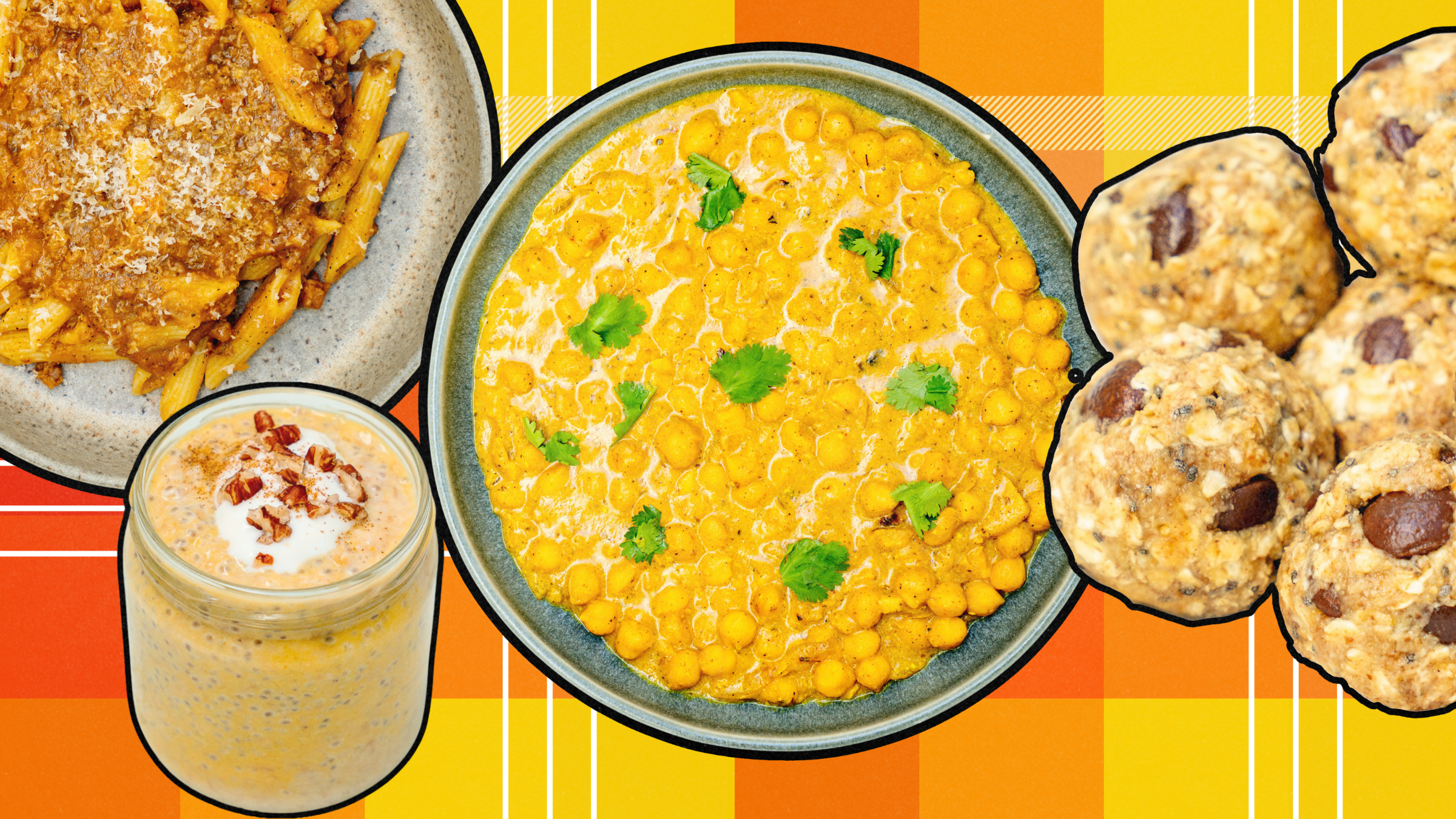
(Photo: Recipes: Ashia Aubourg; Design: Ayana Underwood/Canva)
Pumpkin season returns every year with lattes, pies, and donuts in tow. But beyond the sweet nostalgia, can the orange squash actually fuel an active lifestyle? It turns out that the four protein pumpkin recipes I found can.
“Pumpkin offers a wide range of vitamins and antioxidants that can support your body,” says Yvette Hill, a registered dietitian nutritionist based in Boulder, Colorado. One cup of pumpkin purée provides 7 grams of fiber, 505 milligrams of phosphorus, 63 milligrams of calcium, and over 10 milligrams of vitamin C.
Pair pumpkin with protein, and you’ve got a superfood. “Protein helps build muscle, supports your immune system, and keeps you feeling fuller for longer,” says Hill. That’s a serious advantage if you’re heading out for a long hike or want to recover faster after getting banged up while traversing on rocky terrain.
Hill recommends aiming for 20 to 30 grams of protein per meal. If that sounds like a lot, don’t stress, snacks count too. Spread your intake throughout the day and you’ll hit your goal more easily than you think.
If you’re ready for something more exciting and satisfying than the usual pumpkin muffins, smoothies, and lattes this season has to offer, try these fun and nutritious, nutritionist-approved pumpkin recipes below.
1. Pumpkin Pie Overnight Oats with Chia Seeds
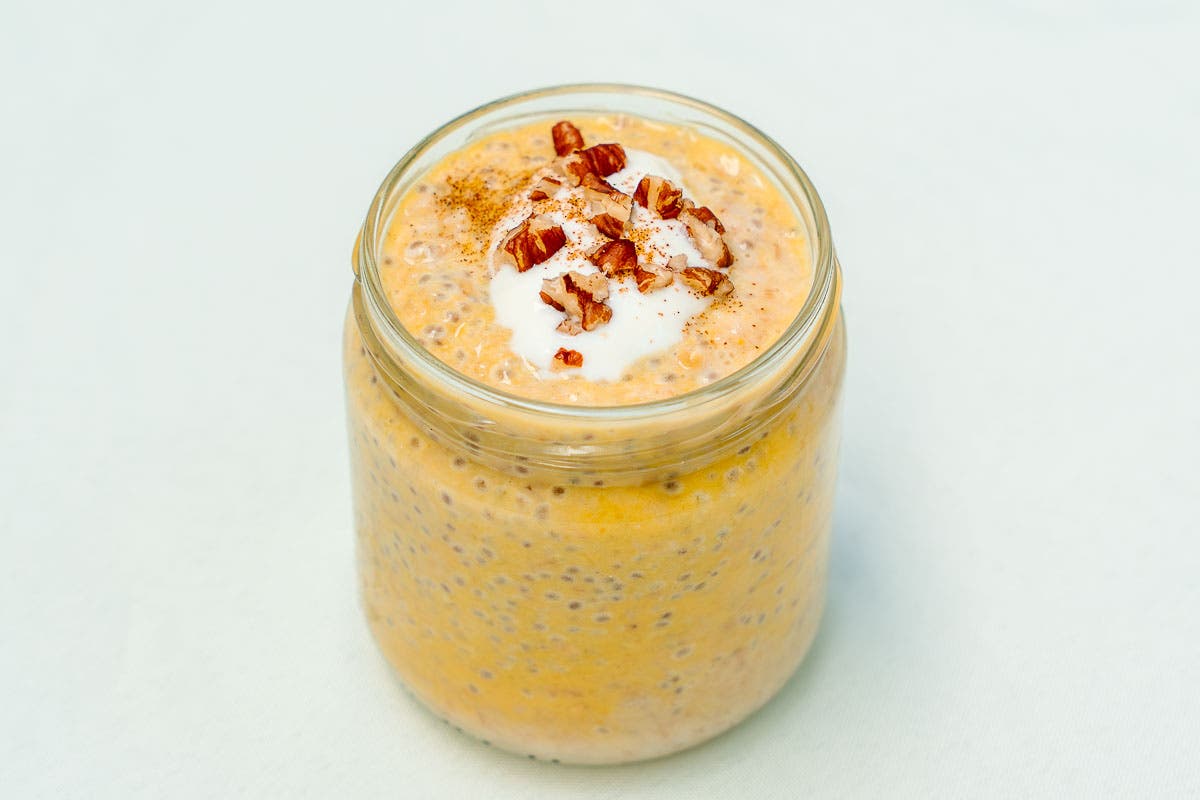
I recently tested this pumpkin pie overnight oats recipe for a story about balancing blood sugar. It was delicious, so I was excited to learn that it doubles as a high-protein breakfast.
Yield: 1 eight-ounce serving
Ingredients:
- ¼ cup plain Greek yogurt
- ½ cup unsweetened vanilla almond milk
- ¼ cup pumpkin purée
- 1-2 tablespoons maple syrup
- ½ teaspoon vanilla extract
- ½ cup rolled oats
- 2 teaspoons chia seeds
- ½ teaspoon pumpkin pie spice
Recipe:
- In a bowl, whisk together Greek yogurt, almond milk, pumpkin purée, vanilla, and maple syrup. Stir in the oats, chia seeds, and pumpkin spice until thoroughly mixed.
- Scoop the mixture into a sealable jar or container and store it in the fridge overnight, or for at least four hours.
“The oats, chia seeds, and Greek yogurt make this breakfast a good source of protein,” says Hill—a single serving provides nearly 18 grams—enough to keep you full through the morning.
To level it up, Hill suggests mixing in 1/4 cup of peanut butter and 1/4 cup of almonds. That combo can push the total to over 40 grams of protein.
The Verdict: Filling and Decadent
I’ve made this recipe before, and it couldn’t be more straightforward. If you meal prep regularly, it deserves a spot in your rotation. It takes about five minutes to assemble, then the fridge handles the rest. The oats set into a mousse-like texture with that familiar, cozy pumpkin spice flavor. I took Hill’s tip and stirred in a spoonful of peanut butter, which added richness and a hint of salt that balances its sweetness without overpowering the pumpkin. I ate it right before a hike and stayed full the entire trek.
2. Pumpkin Butter Chickpeas
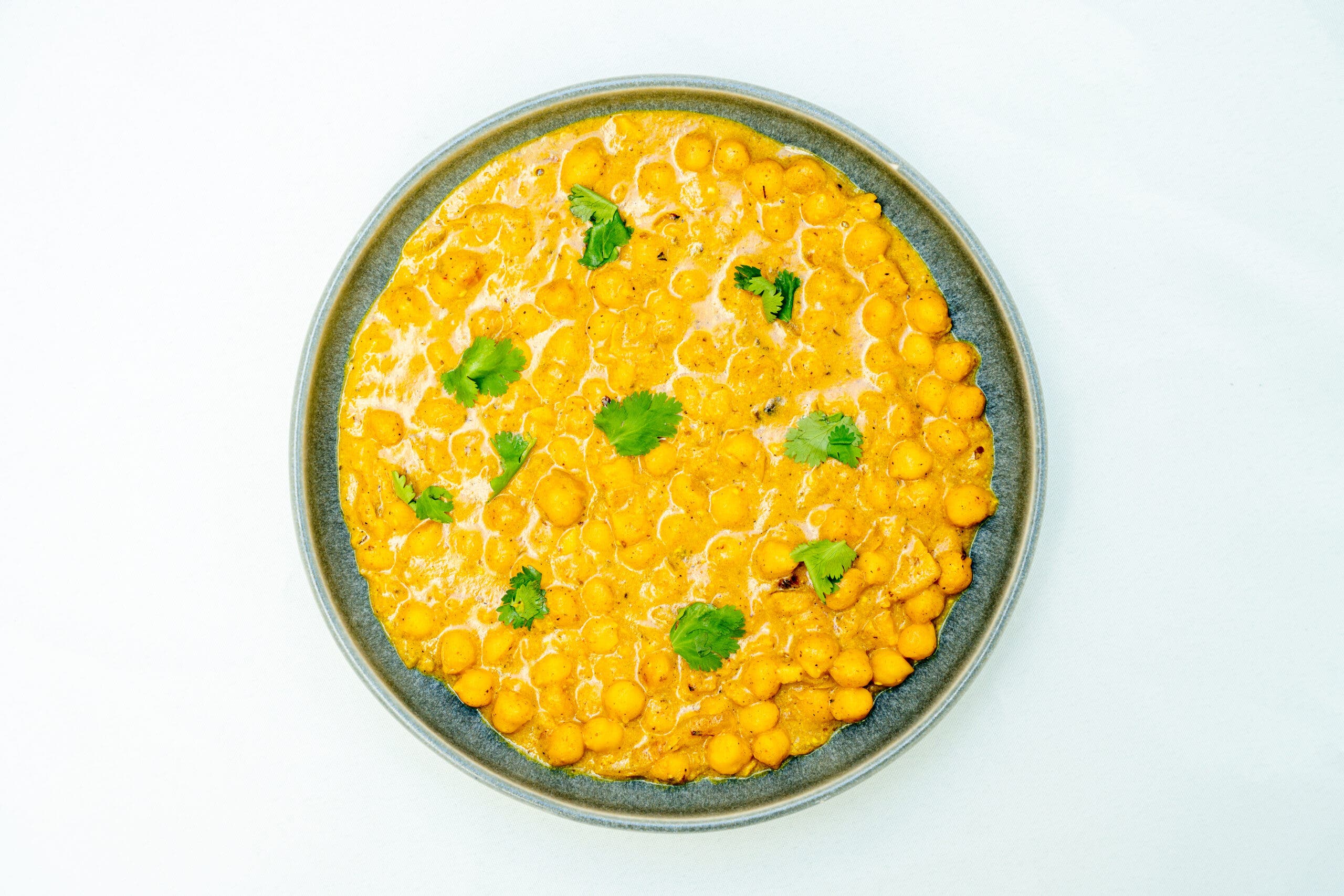
After a big hike, I usually go for butter chicken. It’s one of my go-to takeout meals. So when I came across a chickpea version, I had to try it. Instead of tomatoes, the creator uses pumpkin purée to build the sauce, and that twist sealed the deal. I skipped ordering out and cooked it myself.
Yield: 4 servings
Ingredients:
- 2 tablespoons extra virgin olive oil
- 1/2 medium yellow onion, chopped
- 4 cloves garlic, minced
- 2 inches of fresh ginger, grated
- 1 tablespoon garam masala
- 2 teaspoons yellow curry powder
- 1/2 teaspoon turmeric
- 1 teaspoon cayenne pepper
- kosher salt and black pepper, to taste
- 2 cans (14 ounce) chickpeas, drained
- 1 can (14 ounce) full-fat coconut milk
- 1 cup pumpkin purée
- 2 tablespoons tomato paste
- 2 tablespoons salted butter (coconut oil if you follow a vegan diet)
- 1/4 cup fresh cilantro, roughly chopped
Recipe:
- Heat the olive oil in a large pan over medium heat. Add the onions and cook for five minutes or until fragrant. Add the garlic and ginger, cooking for an additional two minutes. Stir in the garam masala, curry powder, turmeric, cayenne, and a pinch of salt and pepper. Cook for about one more minute.
- Add the chickpeas and toss to coat with the spices.
- Stir in the coconut milk, pumpkin purée, tomato paste, butter, and 1/2 a cup of water. Simmer for five minutes, until the sauce has thickened slightly. Remove from the heat and stir in the cilantro. Season with salt and pepper, to taste.
- Serve the chickpeas on their own or with rice, naan, or quinoa.
This dish holds up on its own, says Hill. There are approximately seven ounces of chickpeas in one serving of this dish, which provides around 13 grams of protein. In one serving, the coconut milk adds an extra three grams of protein. For an extra protein boost, Hill suggests serving this curry over half a cup of quinoa. That simple addition adds over 11 more grams, bringing the total to 27 grams, turning this comfort food into a protein superfood.
The Verdict: Hearty Comfort Food with a Little Spice
I went for a hike and didn’t walk away with any injuries, but the soreness hit hard, which is pretty normal for me. This pain sometimes lingers into the next morning, so I wanted something quick and restorative for dinner once I got home. This meal came together in just 30 minutes, and I couldn’t stop going back for more. The chickpeas, coated in a rich, pumpkin butter sauce, tasted slightly sweet with just enough heat from the pinches of cayenne pepper. The next day, although I still felt a little sore, I had the energy actually to move through my day.
3. Pumpkin Protein Balls
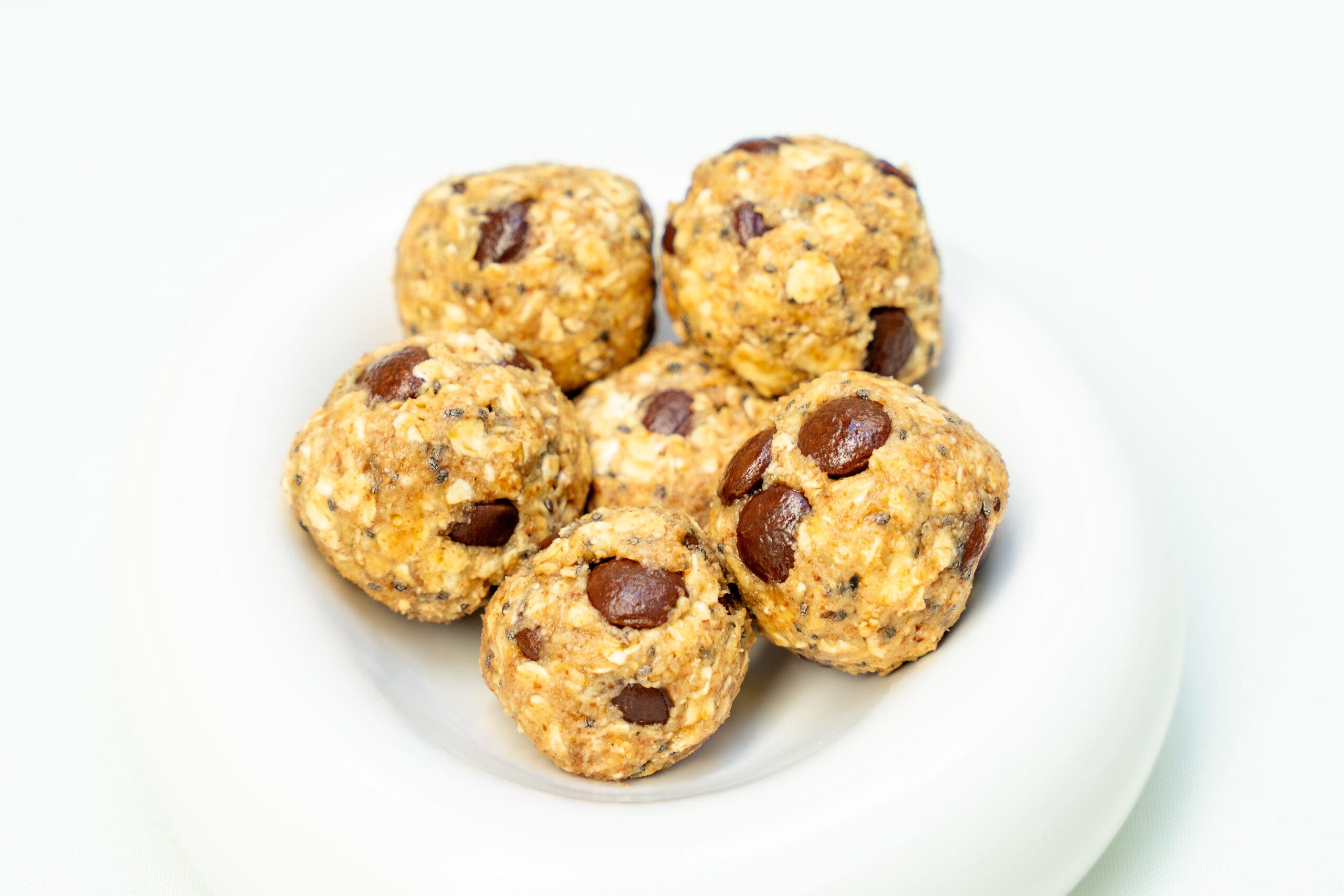
I always keep a stash of protein bites in the fridge. Whether it’s pro climber Sasha DiGiulian’s bars or cheese sticks, I like having something quick and satisfying within reach. So, when I found a recipe that combines oats, peanut butter, pumpkin purée, and other good ingredients into bite-sized fuel, I knew I had to try it.
Yield: 12 balls
Ingredients:
- 3/4 cup old-fashioned rolled oats
- 1/4 cup almond butter
- 1/4 cup pumpkin purée
- 1 scoop (25 grams) vanilla protein powder
- 1/2 tablespoon ground flaxseed
- 1/2 teaspoon pumpkin pie spice
- 1 teaspoon chia seeds
- 3 tablespoons maple syrup
- Pinch of cinnamon
- 1 tablespoon chocolate chips
Recipe:
- Add all the ingredients to a bowl and stir until well combined.
- Once mixed, use a small ice cream scoop or tablespoon to dig out and form the dough into 12 balls.
- Store in an airtight container in the refrigerator for up to one week or in the freezer for up to three months.
This snack provides a solid source of protein from oats, chia seeds, almond butter, and a scoop of powder. Each bite packs around five grams of protein, making it an easy win for pre- or post-workout recovery or trail fuel. While the recipe calls for vanilla protein powder, chocolate or coffee-flavored powders work just as well to keep things interesting.
The Verdict: Easy and Delectable
Even though I write about protein all the time (and fully understand its benefits), I don’t always hit 20 grams per meal. Life gets busy. What I like about these bites is that they offer small wins throughout the day. Grabbing two or three puts me halfway to my protein goal before dinner even starts. And they’re so good. These bites taste like pumpkin oatmeal cookies with a gooey, cookie-dough-like texture.
4. Pumpkin Bolognese
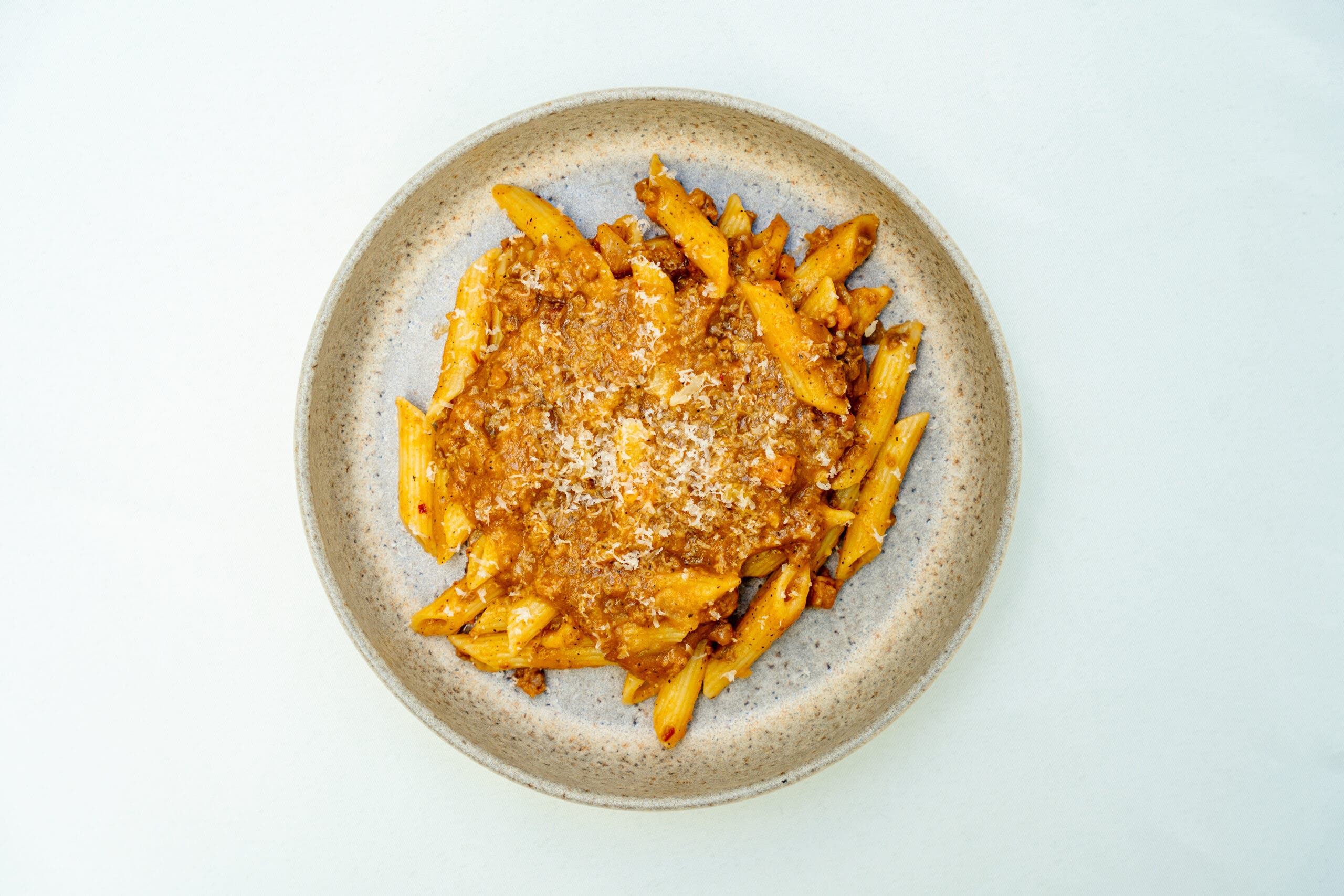
Bolognese is a classic Italian pasta dish built with ground beef, aromatics, and a rich tomato base. But a version from the blog Mon Petit Four caught my eye. Instead of red sauce, it uses pumpkin purée. I had to try it.
Yield: 6 servings
Ingredients:
- 1 box of pasta
- 1 tablespoon extra virgin olive oil
- 1/2 large onion, diced
- 2 cloves garlic, minced
- 1 medium carrot, finely chopped
- 1 celery stalk, finely chopped
- 1 teaspoon dried oregano
- 1 pound ground beef
- 1/2 cup tomato paste
- 3/4 cup pumpkin purée
- salt and pepper, to taste
- reserved pasta water
Recipe:
- Cook the pasta according to the package directions, adding one tablespoon of salt to the water in the pot. Drain the pasta, reserving some of the pasta water.
- In a large pan over medium heat, warm the olive oil. Add the diced onion and cook until translucent, about three minutes. Add the garlic, carrot, celery, and dried oregano. Sauté for five minutes, until the vegetables become tender.
- Add the ground beef and break it up into smaller pieces. Cook the beef until it’s browned, then add the tomato paste and pumpkin purée. Add a generous pinch of salt and pepper. Stir everything together and let the paste and purée cook with the beef for a couple of minutes.
- Add some of the reserved pasta water, one ladle at a time (about 1/4 cup), until the sauce is as thick or loose as you like it. Allow the sauce to simmer on low heat for a minute.
- If your pan is big enough, toss the pasta with the sauce in the pan. If not, then pour the sauce over the spaghetti.
Hill gives the recipe high marks as is. One serving of this dish contains approximately three ounces of ground beef, providing nearly 16 grams of protein. For an extra boost, she recommends substituting regular pasta with pasta made from red lentils. That simple switch can increase the total protein content from three grams in the regular pasta to nearly 15 grams in one serving of this dish. So, if you didn’t get your protein intake in at lunch, don’t worry—dinner has you covered.
The Verdict: A Tasty Way to Upgrade Bolognese
This pumpkin Bolognese hit all the right notes: rich, satisfying, and just as flavorful as the traditional version, with a little extra creaminess from the purée. The sauce leaned slightly sweet, as expected, so I added a few shakes of red pepper flakes to bring some heat. It left me full and fueled. The next morning, I headed out for a beach jog, feeling strong, a reminder that pumpkin pulls double duty: it’s both a seasonal comfort food in the kitchen and a performance fuel on the trail.
Want more Outside health stories? Sign up for the Bodywork newsletter. Ready to push yourself? Enter MapMyRun’s You vs. the Year 2025 running challenge.